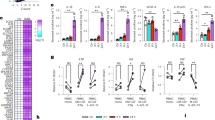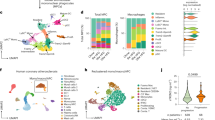Abstract
Macrophage type-I and type-II class-A scavenger receptors (MSR-A) are implicated in the pathological deposition of cholesterol during atherogenesis as a result of receptor-mediated uptake of modified low-density lipoproteins (mLDL)1–6. MSR-A can bind an extraordinarily wide range of ligands, including bacterial pathogens7, and also mediates cation-independent macrophage adhesion in vitro8. Here we show that targeted disruption of the MSR-A gene in mice results in a reduction in the size of atherosclerotic lesions in an animal deficient in apolipoprotein E. Macrophages from MSR-A-deficient mice show a marked decrease in mLDL uptake in vitro, whereas mLDL clearance from plasma occurs at a normal rate, indicating that there may be alternative mechanisms for removing mLDL from the circulation. In addition, MSR-A-knockout mice show an increased susceptibility to infection with Listeria monocytogenes or herpes simplex virus type-1, indicating that MSR-A may play a part in host defence against pathogens.
This is a preview of subscription content, access via your institution
Access options
Subscribe to this journal
Receive 51 print issues and online access
$199.00 per year
only $3.90 per issue
Buy this article
- Purchase on Springer Link
- Instant access to full article PDF
Prices may be subject to local taxes which are calculated during checkout
Similar content being viewed by others
References
Brown, M. S. & Goldstein, J. L. Lipoprotein metabolism in the macrophage: Implications for cholesterol deposition in atherosclerosis. Annu. Rev. Biochem. 52, 223–261 (1983).
Kodama, T. et al. Type I macrophage scavenger receptor contains α-helical and collagen-like coiled coils. Nature 343, 531–570 (1990).
Rohrer, L., Freeman, M., Kodama, T., Penman, M. & Krieger, M. Coiled-coil fibrous domains mediate ligand binding by macrophage scavenger receptor type II. Nature 343, 570–572 (1990).
Krieger, M. & Herz, J. Structures and functions of multiligand lipoprotein receptors: Macrophage scavenger receptors and LDL receptor-related protein (LRP). Annu. Rev. Biochem. 63, 601–637 (1994).
Steinberg, D., Parthasarathy, S., Carew, T. E., Khoo, J. C. & Witztum, J. L. Beyond cholesterol. Modifcations of low-density lipoprotein that increase its atherogenicity. N. Engl. J. Med. 320, 915–924 (1989).
Naito, M. et al. Coexpression of type I and type II human macrophage scavenger receptors in macrophages of various organs and foam cells in atherosclerotic lesions. Am. J. Path. 141, 591–599 (1992).
Dunne, D. W., Resnick, D., Greenberg, J., Krieger, M. & Joiner, K. A. The type I macrophage scavenger receptor binds to Gram-positive bacteria and recognizes lipoteichoic acid. Proc. Natl Acad. Sci. USA 91, 1863–1867 (1994).
Fraser, I. P., Hughes, D. A. & Gordon, S. Divalent cation-independent macrophage adhesion inhibited by monoclonal antibody to murine scavenger receptor. Nature 364, 343–346 (1993).
Kodama, T., Reddy, P., Kishimoto, C. & Krieger, M. Purification and characterization of a bovine acetyle low density lipoprotein receptor. Proc. Natl Acad. Sci. USA 85, 9238–9242 (1988).
Hughes, D. A., Fraser, I. P. & Gordon, S. Murine macrophage scavenger receptor: in vivo expression and function as receptor for macrophage adhesion in lymphoid and non-lymphoid organs. Eur. J. Immunol. 25, 466–473 (1995).
Schmidt, A. M. et al. Isolation and characterization of two binding proteins for advanced glycosylation end products from bovine lung which are present on the endothelial cell surface. J. Biol. Chem. 267, 14987–14997 (1992).
Smith, J. D. et al. Decreased atherosclerosis in mice deficient in both macrophage colony-stimulating factor (op) and apolipoprotein E. Proc. Natl Acad. Sci. USA 92, 8264–8268 (1995).
van Ree, J. H. et al. Variability in cholesterol content in serum and aortic tissue in apolipopotein E-deficient mice is comparable in inbred (129/Sv) and outbred (mixed 129/Sv and C57BL/6) mice. Atherosclerosis 118, 165–167 (1995).
Zhang, S. H., Reddick, R. L., Piedrahita, J. A. & Maeda, N. Spontaneous hypercholesterolemia and arterial lesions in mice lacking apolipoprotein E. Science 258, 468–471 (1992).
Zhang, S. H., Reddick, R. L., Burkey, B. & Maeda, N. Diet-induced atherosclerosis in mice heterozygous and homozygous for apolipoprotein E gene disruption. J. Clin. Invest. 94, 937–945 (1994).
Plump, A. S. et al. Severe hypercholesterolemia and atherosclerosis in apolipoprotein E-deficient mice created by homologous recombination in ES cells. Cell 71, 343–353 (1992).
Holness, C. L., da Silva, R. P., Fawcett, J., Gordon, S. & Simmons, D. Macrosialin, a mouse macrophage-restricted glycoprotein, is a member of the lamp/lgp family. J. Biol. Chern. 268, 9661–9666 (1993).
Elomaa, O. et al. Cloning of a novel bacteria-binding receptor structurally related to scavenger receptors and expressed in a subset of macrophages. Cell 80, 603–609 (1995).
Ramprasad, M. P. et al. The 94- to 97-kDa mouse macrophage membrane protein that recognizes oxidized low density lipoprotein and phosphatidylserine-rich liposomes is identical to macrosialin, the mouse homologue of human CD68. Proc. Natl Acad. Sci. USA 92, 9580–9584 (1995).
Endemann, G. et al. CD36 is a receptor for oxidized low density lipoprotein. J. Biol. Chem. 268, 11811–11816 (1993).
Acton, S. et al. Identification of scavenger receptor SR-B1 as a high density lipoporotein receptor. Science 271, 518–520 (1996).
Azuma, S. & Toyoda, Y. Production of a germ-line chimeric mouse derived from newly established embryonic stem cells. Jpn. J. Anitm. Reprod. 37, 37–43 (1991).
Kurihara, Y. et al. Elevated blood pressure and craniofacial abnormalities in mice deficient in endothelin-1. Nature 368, 703–710 (1994).
Suzuki, H., Togashi, M., Moriguchi, Y. & Adachi, J. Relationship between age-related decline in fertility and in vitro fertilization rate in IVCS mice. J. Reprod. Dev. 40, 107–116 (1994).
Cynshi, O. et al. Characterization of aggregated low density lipoproteins induced by copper-catalyzed oxidation. J. Atheroscler. Thromb. 1, 87–97 (1994).
Takata, K. et al. Endocytic uptake of nonenzymatically glycosylated proteins is mediated by a scavenger receptor for aldehyde-modified proteins. J. Biol. Chem. 263, 14819–14825 (1988).
Irie, H. et al. Spread of herpes simplex virus type-1 (Miyama +GC strain) to the central nervous system after intraperitoneal inoculation: the role of the myenteric plexus of the gut. Arch. Virol. 105, 247–257 (1989).
van Berkel, T. J. C., Kruijt, J. K. & Kempen, H.-J. M. Specific targeting of high density lipoproteins to liver hepatocytes by incorporation of a tris-galactoside-terminated cholesterol derivative. J. Biol. Chem. 260, 12203–12207 (1985).
Author information
Authors and Affiliations
Rights and permissions
About this article
Cite this article
Suzuki, H., Kurihara, Y., Takeya, M. et al. A role for macrophage scavenger receptors in atherosclerosis and susceptibility to infection. Nature 386, 292–296 (1997). https://doi.org/10.1038/386292a0
Received:
Accepted:
Issue Date:
DOI: https://doi.org/10.1038/386292a0
This article is cited by
-
The application of MARCO for immune regulation and treatment
Molecular Biology Reports (2024)
-
Lipid metabolism reprogramming in tumor-associated macrophages and implications for therapy
Lipids in Health and Disease (2023)
-
Emerging strategies in targeting tumor-resident myeloid cells for cancer immunotherapy
Journal of Hematology & Oncology (2022)
-
Transmembrane stem cell factor protein therapeutics enhance revascularization in ischemia without mast cell activation
Nature Communications (2022)
-
LDL delivery of microbial small RNAs drives atherosclerosis through macrophage TLR8
Nature Cell Biology (2022)
Comments
By submitting a comment you agree to abide by our Terms and Community Guidelines. If you find something abusive or that does not comply with our terms or guidelines please flag it as inappropriate.



